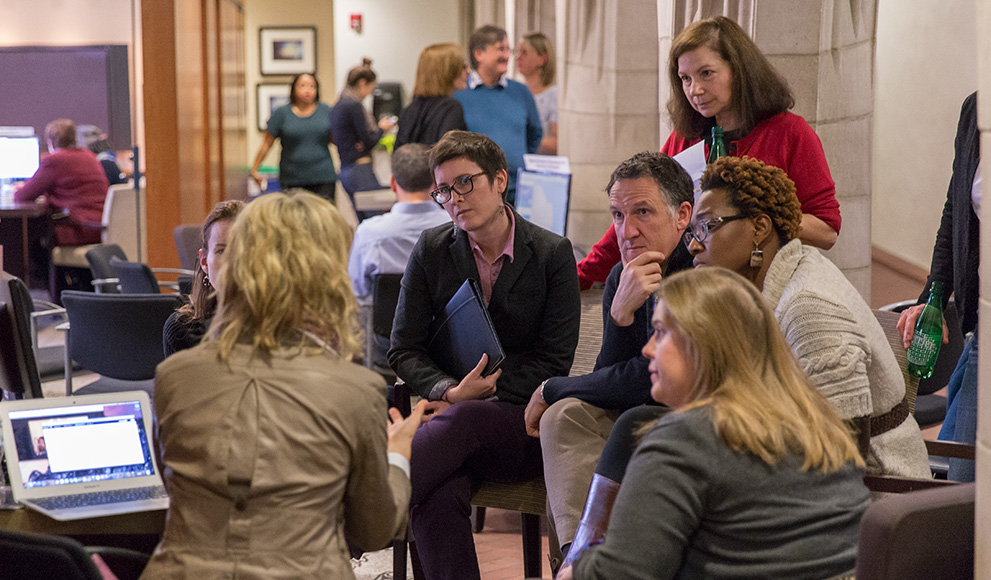Mellon Blended Learning Initiative Supports Innovative Integration Of Technology Into Teaching

In the summer of 2014, the College received a three-year grant from the Andrew W. Mellon Foundation to support blended learning in the humanities and humanistic social sciences. An event held earlier this month marked the halfway point in the grant. This celebratory event, entitled “Discussing the Digital Liberal Arts,” showcased the work faculty supported by the Blended Learning Initiative have accomplished thus far. It also brought faculty together in conversation on topics that ranged from building a successful blended project to expanding the physical limits of the classroom thanks to digital technologies.
"At Wellesley, blended learning builds on [the College's] historic strength in providing outstanding, personalized instruction to a highly motivated and diverse student body," said Evelina Guzauskyte, associate professor of Spanish and Faculty Director of the Andrew W. Mellon Blended Learning Initiative. "It helps us stay dynamic and current, and meet evolving student needs."
Wellesley has, thus far, adopted a purposely broad definition of blended learning in order to encourage faculty to experiment, try different approaches, and to learn from one another through collaboration and dialogue.
"Fundamentally [blended learning] is about finding the best tools or methods to aid student learning," said David O’Steen, senior instructional technologist and associate director of the Blended Learning Initiative. "This can take many forms, and must match the subject and the professor's pedagogical goals and style. In one course, recording some material may free up class time for more complex group work…in another, online tools may enable student voices not commonly heard in class to be expressed in a different medium."
O’Steen said faculty are excited about the opportunity to expand the interdisciplinary aspects of their courses, such as incorporating humanities topics into statistics problems (and vice-versa), or broadening the types of work students engage in. He also said students report that they value and are learning from authentic projects, many of which reach beyond the classroom, like publishing on social media which gives them experience writing for and engaging with a public audience.
The main goals of the Blended Learning Initiative are: to support the innovative integration of technology into teaching; to acquaint faculty with a range of digital pedagogical tools and to facilitate conversations about these in workshops, presentations, and focus groups on campus as well as at outside conferences; and to support the establishment of a long-term sustainable organizational structure to support blended learning as an ongoing practice. There are assessment projects underway which will help bring a deeper understanding of how blended approaches advance student learning.
"The three-year Mellon-supported program brings digital technologies into the humanities classroom, putting us at the cutting edge of current pedagogy," said Kathryn Lynch, Katharine Lee Bates and Sophie Chantal Hart Professor of English and Dean of Faculty Affairs. "The response of humanities faculty to the challenge of this grant has been inspirational."
The success of this initiative was made possible thanks to contributions and collaborative efforts from faculty, LTS staff, and students. To date, more than 25 faculty members in the humanities, some working collaboratively and some introducing blended learning in multiple courses, have used the grant in over 30 humanities and cross-disciplinary classes—and the number keeps growing. A video on the initiative's website presents a selection of recent projects. Particular strengths, as well as focus groups, have emerged in the foreign languages (10 languages are currently using blended approaches), writing, teaching methods involving video, as well as digital humanities as a pedagogical tool.
"Faculty response since our recent event has been particularly heartening," said Guzauskyte, "and we anticipate that over the next year blended projects will grow both in number and complexity."
For some faculty, the incorporation of technology in this way is a new effort, though Guzauskyte pointed out that others have been engaging in forms of blended learning for a long time. "As Wellesley faculty, if there’s one thing that unites all of us, it’s our commitment to teaching," she said. "We may have different passions and areas of expertise, but that’s the one thing that's common among all of us: a commitment to excellence in teaching. Blended learning provides another entry point toward achieving that goal."
The Blended Learning Initiative opens doors for all faculty members to try something new, whether it means doing some of the instruction online to provide additional space for deeper discussions in the classroom, or overhauling an existing course to create opportunities for students to work collaboratively, or perhaps expanding the physical limits of the classroom to allow for greater public engagement and for learning from scholars and together with other audiences nationally and globally.
For those considering trying a blended approach in a course, Guzauskyte has this advice: "Don’t be afraid to start small, choose a specific teaching challenge or goal for your students that you can address in a well defined project, and implement it to see what has worked and where you can take it next."
The next deadline for proposals is February 22, 2016.
